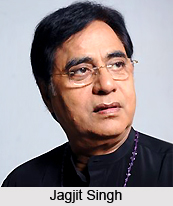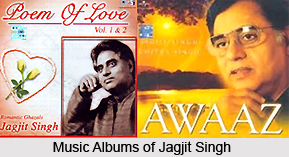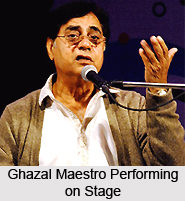 Jagjit Singh is a name that has been considered as the Ghazal King. He has been counted one amongst the most popular ghazal singers of the world. Jagjit Singh was born on 8th February, in the year 1941 in Ganganagar, then in Rajputana in British India. He was born to father Sardar Amar Singh Dhiman, who was employed with the Government of India, hailed from Dalla village in Ropar district of Punjab and his mother Bachchan Kaur came from a deeply religious Sikh family of Ottallan village near Samralla. He has four sisters and a brother. Urdu, Punjabi, Hindi languages, and Gujarati language are the languages in which Jagjit Singh has executed songs.
Jagjit Singh is a name that has been considered as the Ghazal King. He has been counted one amongst the most popular ghazal singers of the world. Jagjit Singh was born on 8th February, in the year 1941 in Ganganagar, then in Rajputana in British India. He was born to father Sardar Amar Singh Dhiman, who was employed with the Government of India, hailed from Dalla village in Ropar district of Punjab and his mother Bachchan Kaur came from a deeply religious Sikh family of Ottallan village near Samralla. He has four sisters and a brother. Urdu, Punjabi, Hindi languages, and Gujarati language are the languages in which Jagjit Singh has executed songs.
It was his father`s wise decision to become a bureaucrat by joining the Indian Administrative Service. Jagjit Singh studied at Khalsa High School at Ganganagar. After passing matriculation, he studied Sciences from Government College, Ganganagar and went for graduation to DAV College, Jalandhar in arts stream. from Kurukshetra University, Haryana he also obtaind a post-graduate degree in history. But Jagjit Singh`s passion for music was with him since his childhood. For two years in Ganganagar he received training in music under the expert tutelage of Pandit Chaganlal Sharma. Then after he consecreted six years to learning Khayal, Thumri and Dhrupad forms of Indian Classical Music from Ustad Jamaal Khan of Sainia Gharana. Acknowledging his talent the Vice Chancellor of Punjab and Kurukshetra University, Late Professor Suraj Bhan supported him to persue music further.
 Jagjit Singh came down to Mumbai in the year 1965 with a dream of establishing himself as a musician and singer as well. He jgot his early assignments to sing for advertisement jingles or executing at weddings and parties. At the time in the 1970s the world of ghazal singing was rulling by the legendary singers like Noor Jehan, Malika Pukhraj, Begum Akhtar,Talat Mahmood and Mehdi Hassan. But with a hardcore struggle Jagjit Singh finally managed to carve a distinct place for himself in the arena. In the year 1976, his first album, The Unforgettables (On HMV LP Records) was a big hit and since then he had never looked back. The album was entirely a ghazal album but the vehemence on melody and a fresh voice like Jagjit Singh can be considered as the jump from the tradition old style of ghazal rendition.
Jagjit Singh came down to Mumbai in the year 1965 with a dream of establishing himself as a musician and singer as well. He jgot his early assignments to sing for advertisement jingles or executing at weddings and parties. At the time in the 1970s the world of ghazal singing was rulling by the legendary singers like Noor Jehan, Malika Pukhraj, Begum Akhtar,Talat Mahmood and Mehdi Hassan. But with a hardcore struggle Jagjit Singh finally managed to carve a distinct place for himself in the arena. In the year 1976, his first album, The Unforgettables (On HMV LP Records) was a big hit and since then he had never looked back. The album was entirely a ghazal album but the vehemence on melody and a fresh voice like Jagjit Singh can be considered as the jump from the tradition old style of ghazal rendition.
The tradition old style of ghazal singing can be charecterised as `heavily based on classical and semi-classical Indian music`. The album was a huge success though it received critical acclaimation, many criticisms. The album set new sales records. After a two year long courtship from the year 1967, finally Jagjit Singh and Chitra Singh got married. It has been said that, `they epitomise the first successful husband-wife singing team`. The contribution of this singing duo towards altering the course of this genre of music known as `Ghazal` can be termed as immense. They both together made this genre of music `Ghazal` more `ear friendly, melodic and enojoyable`. Ghazal became apprehensible with the execution of this duo.
 Ecstasies, A Sound Affair and Passions are the later successful edition of the duo. In the year 1990, breezy, Beyond Time are the experimental albums with sounds that pass on the kind of felling that is beyond space and time. At this time this singing couple faced an untimely tragic disaster, the death of their son, Vivek Singh. He was only twenty-one year young boy. Beyond Time is a album which involves `a tour to the soul, ethereal, conscientious and introspective`. The ghazals that have been executed in the album are the expression of the personal loss of Jagjit and Chitra. Chitra Singh for the last time lend her voice with her husband in the album `Someone Somewhere`. After that she quit singing as she could not bear the trauma of her son`s death.
Ecstasies, A Sound Affair and Passions are the later successful edition of the duo. In the year 1990, breezy, Beyond Time are the experimental albums with sounds that pass on the kind of felling that is beyond space and time. At this time this singing couple faced an untimely tragic disaster, the death of their son, Vivek Singh. He was only twenty-one year young boy. Beyond Time is a album which involves `a tour to the soul, ethereal, conscientious and introspective`. The ghazals that have been executed in the album are the expression of the personal loss of Jagjit and Chitra. Chitra Singh for the last time lend her voice with her husband in the album `Someone Somewhere`. After that she quit singing as she could not bear the trauma of her son`s death.
But Jagjit Singh countinued rendering ghazals. Hope, In Search, Insight, Mirage, Visions, Kahkashan (meaning "Galaxy"), Love Is Blind, Chirag (meaning "Lamp"/"Flame") are the later albums, which were also huge hits. Sajda (an Urdu word meaning "offering") was an album where Jagjit Singh paired with Lata Mangeshkar. Sajda was another extraordinary album. This album has been marked as a classic Ghazal album. The success of his all the album made him the icon of ghazal singer in India. He has also released many Punjabi albums also which were `ebullient, effervescent, bubbly and pleasant as well as joyous`.
Jagjit Singh`s albums involves the poetry`s from the legendary poets like Mirza Ghalib, Ameer Meenai, Kafeel Aazer, Sudarshan Faakir and Nida Fazli and contemporary writers like Zaka Siddiqi, Nazir Bakri, Faiz Ratlami and Rajesh Reddy. Some ghazals sung by him are, `Apne hothon par sajaana chaahta hoon`; `Kaise kaise haadse sehte rahe`; `Wo jo hum mein tumme qaraar tha tumHe yaad ho ke na yaad ho`; `Patta-patta boota-boota haal hamaara jaane hai`; `Apne haathon kee lakiron meiN basa le mujhko`; `Sadma to hai mujhe bhi ke tujhse juda hoon main`; `Apani aankho ke samundar mein utar jaane de`; `Meri zindagi kisi aur ki, mere naam ka koi aur hai`; `Aadmi aadmi ko kya degaa`; ` Apni marzi se kahan apni safar ke hum hain`; `Ik baramhahn ne kaha hai ke ye saal achhaa hai`; `Main na hindoo na musalmaan mujhe jeene do`; ` Garaj baras pyaasi dharthi par phir paani de maula`; `Chak jigar ke see lete hain`; `Main bhool jaaoon tumhe, ab yahi munaasib hai`; `Jaate jaate wo mujhe achchhi nishaani de gaya`; `Shaam se aankh mein namin si hai`; `Tere baare mein jab socha nahin thaa`; `Tere aane ki jab khabar mehke`; `Tamanna fir machal jaaye agar tum milne aa jaao`; `Ab main ration ki kataron mein nazar aata hoon`; `Tujhse milne ki saza denge tere shehar ke log`; `Patthar ke khuda, patthar ke sanam`; `Huzoor aapka bhi ahtraam karta chaloon`; `Din aa gaye sabaab ke aanchal sambhaaliye`; `Gulshan ki faqat phoolon se nahin kaaton se bhi zeenat hoti hai`; `Baat saaqi ki na taali jaayegi`; ` Chupke chupke raat din aansoon bahana yaad hai`; `Roshan jamal-e-yaar se hai anjuman tamaam`; `Tera chehra kita suhaana lagta hai`; `Tum naihin, gham nahin sharaab nahin`; `Sarakti jaaye hain rukh se naqaab aahistaa-aahista`; `Ae khuda ret ke sehra ko samandar kar de`; `Yeh daulat bhi le lo, yeh shohrat bhi le lo`; `Hoshwalo ko khabar`; `Honthon se chhoo lo tum`; `Koi yeh kaise bataye`; `Tere khat`; `Bahut khoobsurat hai`; `Kiska Chehera`; `Kal chodvi ki raat thi`; `Baat niklegi to`; `Der laagi ane mein tumko`; `Main nashe mein hoon`; `Pyar mujhse jo kiya tumne`; `Tera chehera hai aaeene jaisa`; `Chitthi na koi sandesh`; `Tum itna jo muskura rahe ho`; `Jab se kareeb ho kay chale zindagi se hum`; `Koi fariyaad`; `Kahin duur jab din`; `Kehta hai baabul`; `Jhuki jhuki si nazar`; `Tumko dekha to yeh khayal`; `Sehma sehma`; `Yaad kiya dil ne kaha ho tum`; `Aap ko dekh kar`; `Jab samne tum`; `Hazaron khwaishe hai aisi`.
Jagjit singh also lent his voice for Bollywood films including Arth, Saath Saath and Premgeet during the 1980s. He has also composed all the songs of Premgeet. He has composed music for the films, Leela (2002); Sarfarosh (1999); Khudai (1994); Billoo Badshah (1989); Kaanoon Ki Awaaz (1989); Rahi (1987); Long Da Lishkara (1986); Ravan (1984); Arth (1982); Sitam (1982) (as Jagjit-Chitra); Prem Geet (1981).
He has also composed scores for the TV serial Mirza Ghalib (based on the life of the poet Mirza Ghalib). This scores still today remains extremely popular among ghazal lovers. The album could genuinely be called a `magnum opus`. Compared to his albums of the 70s and 80s, his latest albums are more soulful and touching deportment, as in albums such as Marasim, Face To Face, Aaeena, Cry For Cry. Almost all of the earlier albums of Jagjit Singh had English titles. Later on he used Urdu titles to his albums, Sahar (meaning "Dawn"/"Morning"), Muntazir (meaning "In waiting"), Marasim (meaning "Relation"/"Relationship"/"Affinity" ) "Soz" (Pathos) etc.. Jagjit Singh has also sung Bhajans and Gurbani(Hindu and Sikh devotional hymns respectively) . Albums such as Maa, Hare Krishna, Hey Ram...Hey Ram, Ichhabal and also Man Jeetai Jagjeet in Punjabi.
Acknowledging his talent Jagjit singh has been conferred the Padma Bhusan in the year 2003, one of India`s highest civilian honours, from the Government of India. In the year 2006, he has been conferred Teacher`s Achievement Awards. Mirage (1995); Unique (1996); Come Alive in a Concert (1998 (CD)); Live at the Wembley; Love is Blind (1998); Silsilay (1998) (Lyrics by Javed Akhtar); Marasim (1999) (Lyrics by Gulzar); Saher (2000); Samvedna 2002 (Atal Behari Vajpayee`s poetry)); Soz (2002) (Lyrics by Javed Akhtar); Forget Me Not (2002); Jaam Utha; Muntazir (2004); Tum To Nahin Ho (Lyrics by Bashir Badr) (2005); Best of Jagjit & Chitra Singh (includes Mere Darwaaze Se Ab Chand Ko Ruksat Kar do by Ali Sardar Jaffrey); Koi Baat Chale (Lyrics by Gulzar) are some of his albums.




















